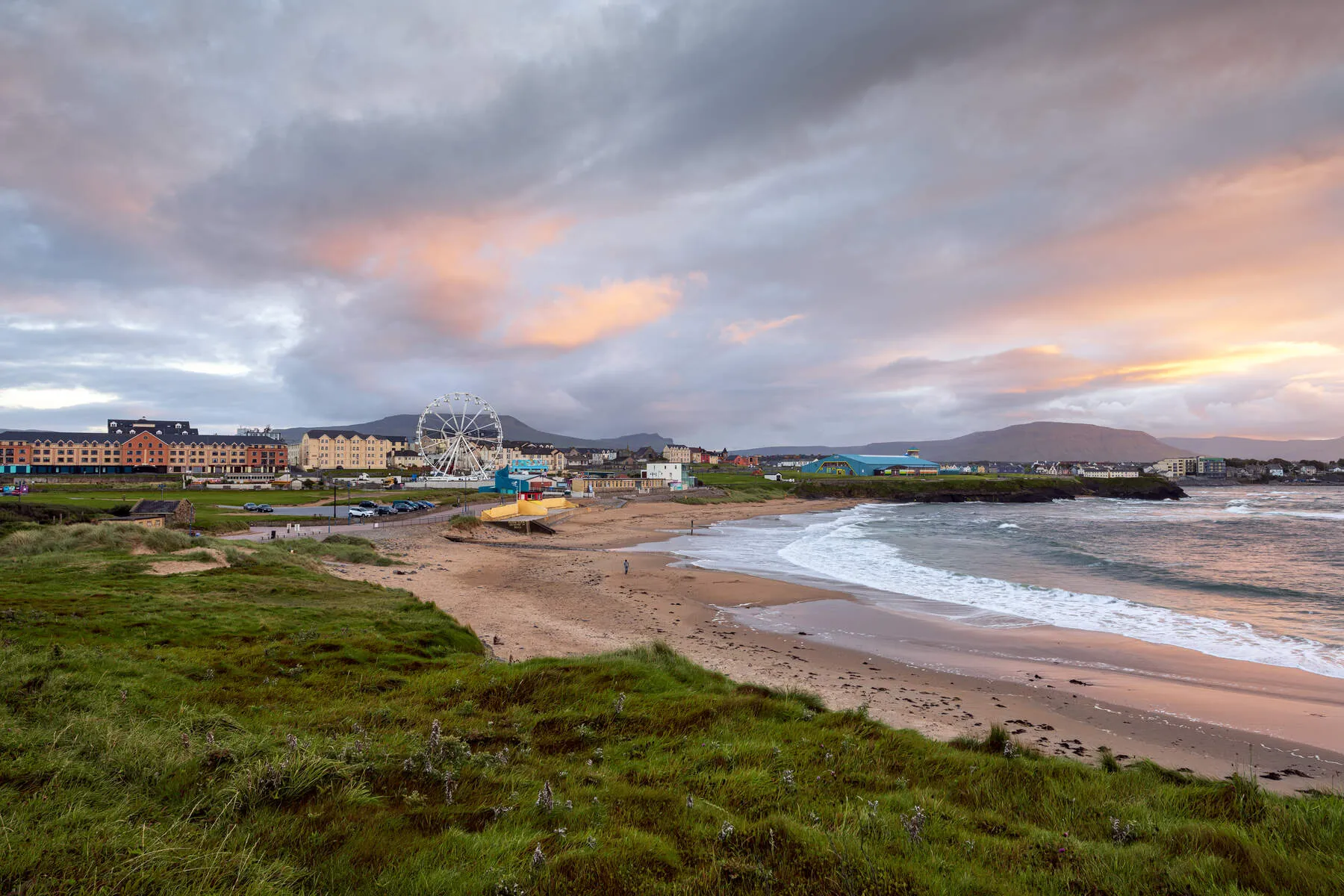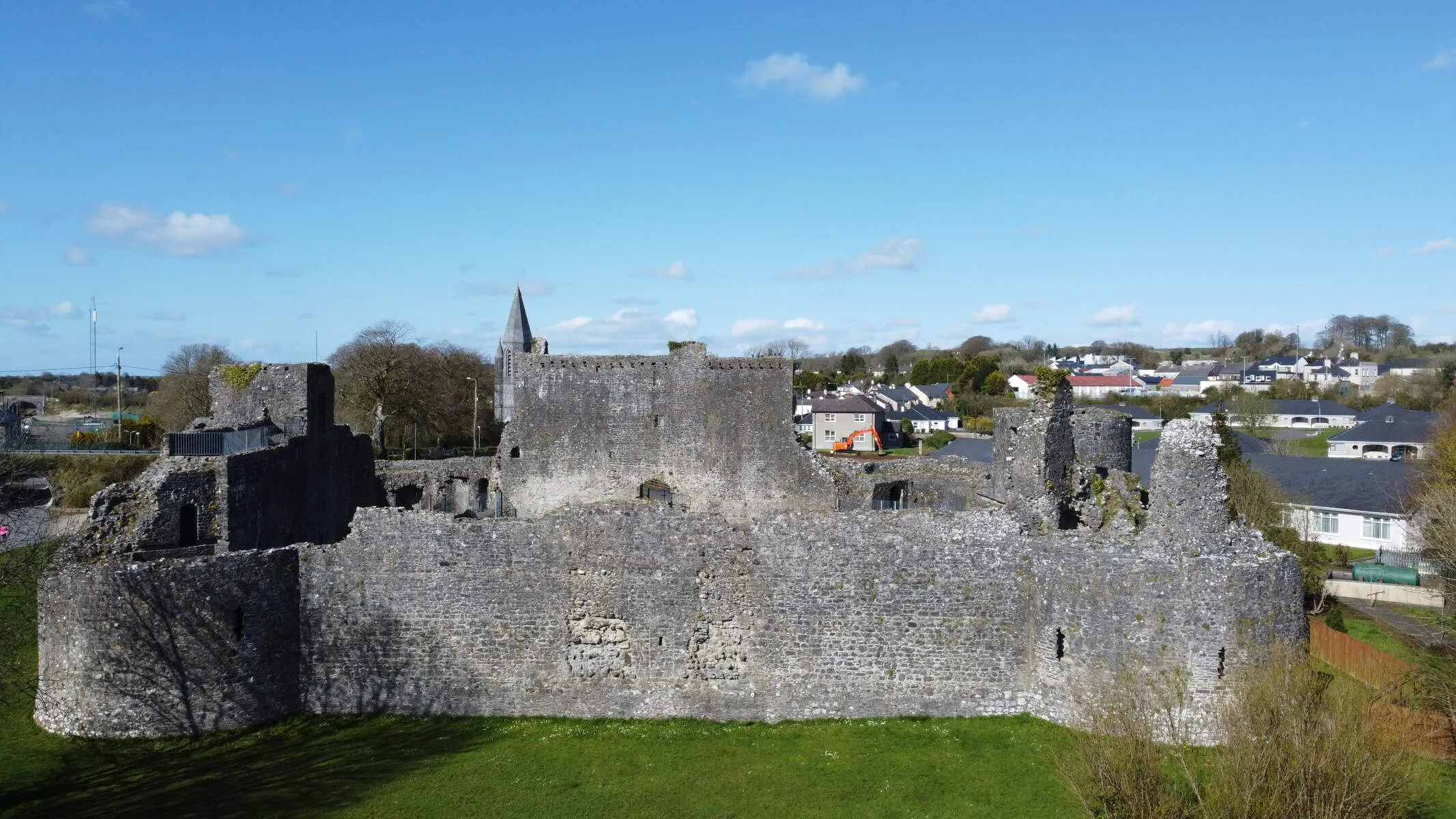On the edge of Ballymote town in County Sligo, the imposing ruins of Ballymote Castle tell a story of Norman ambition in 14th-century Ireland. Built around 1300 by the powerful Norman noble Richard de Burgo (known as the Red Earl of Ulster), it was meant to be both a formidable fortress and a clear symbol of his authority in the often-turbulent province of Connacht. As the last and largest Norman castle built in the region, it represents the peak of their influence before Gaelic clans pushed back and later English colonial struggles changed its fate forever. Its impressive architecture and complex history make it a key site in Ireland's medieval past.
The castle's design shows the advanced military thinking of its time. It's roughly square (about 42 by 40 meters) with thick 3-meter walls strengthened by well-placed towers. Large three-quarter-round towers guard each corner, while D-shaped towers halfway along the east and west walls provided extra defence. The main entrance was the northern gatehouse, protected by huge half-round towers and featuring double walls to prevent attackers from digging underneath, plus a slot for a portcullis (heavy grating). Although now in ruins, the castle's symmetrical layout, similar to Beaumaris Castle in Wales, hints at its original strength. Interestingly, Ballymote didn't have a central keep (main tower), relying instead on its strong outer walls and towers for defence – a "keepless castle" design.
Through the centuries, Ballymote Castle was frequently caught up in conflicts between Irish clans and colonial powers. Captured by the O'Connors and MacDermots in the 14th century, it later fell to the McDonaghs, who held it until English forces took over in the 16th century. One of its most famous moments was in 1601 when Red Hugh O'Donnell (who'd bought it for £400 and 300 cows) used it as a base before the Battle of Kinsale – a defeat that ultimately strengthened English control. After changing hands again during the Williamite Wars in the 1690s, the castle was deliberately slighted – its defences broken down and moat filled in – leaving it the ruin we see today.
You can freely walk around the castle grounds, tracing the footprint of its walls and towers, although the interior is not accessible. Information panels nearby explain its dramatic history. Local folklore even speaks of secret tunnels linking the castle to nearby sites like Emlaghfad church. Visiting in good weather allows you to appreciate the surrounding landscape, including the historic Bóthar an Chorann road also built by the Red Earl. Beyond its military past, Ballymote also lends its name to the important 14th-century Book of Ballymote, a manuscript filled with ancient Irish stories, highlighting its connection to cultural heritage as well. Its weathered stones stand as a powerful reminder of Ireland's complex medieval history.
Getting There
Ireland West Airport Knock is located approximately 30 to 40 minutes' drive away, depending on road conditions. Ballymote Railway Station lies directly on the Dublin to Sligo line, offering direct services to both cities. Trains from Dublin take around 2.5 hours to reach Ballymote, while connections from Sligo take just 25 minutes.
By car, the castle is 193 kilometers west of Dublin, with the quickest route following the M3 motorway to the N4 road. Drivers from Sligo can reach Ballymote in 25 minutes via the R295. The town is also linked by regional roads R293, R295, and R296, which provide connections to surrounding areas like Boyle and Tubbercurry.
Public transport options include Local Link bus services, which run daily to and from nearby towns such as Sligo and Boyle. These buses drop passengers in Ballymote town center, from where the castle is a short walk or drive. The castle sits opposite Ballymote Railway Station on the R296 road, just past the Catholic church, making it easily reachable for those arriving by train.
No ferry services are required to access Ballymote Castle, as road and rail connections are well-established. Once in town, visitors can explore the castle's historic grounds, located on the outskirts near the Ballymote Community Nursing Unit.
Parking
The community park is situated at the town's entrance, placing it within a short walk to Ballymote Castle. If the community park is full, roadside parking may be available.
Pricing
It's free to visit the Castle site.
Nearby Attractions

Bundoran Golf Course
Perched on rugged cliffs overlooking Donegal Bay, Bundoran Golf Club isn't just old – it's one of Ireland's founding golf courses, dating back to 1894. Right on the Wild Atlantic Way, this classic lin...
Distance: 45.0 km

Bundoran Beach (Main Beach)
Bundoran Main Beach, right at the southern tip of County Donegal, is famous throughout Ireland, known especially as the country's 'Surf Capital.' Having hosted European Surfing Championships, its repu...
Distance: 45.2 km
